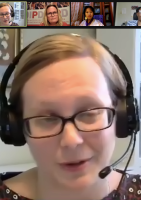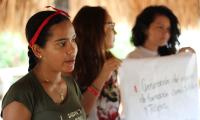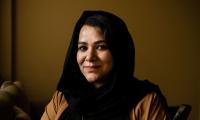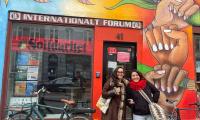Violence against women in politics is about gender not politics
This has dire democratic consequences globally. Legislation, dialogue and cultural nudging are among tools to counter the effects. Apps for online campaigning, bots responding to negativity and sms-reporting systems are also among the tools to fight violence against women in politics
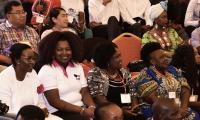
It is not “part of the game”. It is not “the cost of doing business”. It is not even about politics. It is about women. Violence against women in politics aims to keep women out of politics, not just because of politics, but sometimes just because they are women. That is the understanding after women around the world weighed in at the DIPD webinar launching the new book “Violence Against Women in Politics”. Here, researcher Mona Krook traces the attacks, intimidations and harassment that women face all over the globe when making their mark on politics. Her book also presents examples of solutions. An international panel of female politicians and practitioners from Bhutan, Zambia and South Africa shared their experiences, and participants from four continents chimed in.
How is it different from other forms of violence in politics
violence against women in politics is a global problem. Women talk about it across different cultures and very different political systems. They see these acts as gender-biased, aimed at deterring women’s political participation.
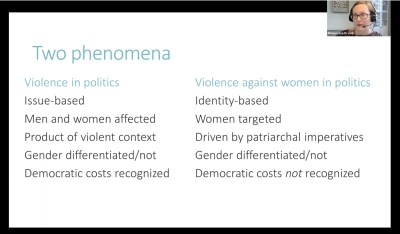
It jeopardizes political rights, hinders political work and erodes public confidence in political institutions
Mona Krook highlights violence against women in politics as a specific and distinctive phenomenon. This form of violence against women in politics is not about politics; it is not about issues. Its motivation is not to gain the upper hand in a political dispute. Its motivation is to exclude women as a group from participating in politics.
Mona Krook highlights that using violence to deter women from participating as women has dire democratic consequences. It keeps politically active women from participating and voicing their oppinion. This erodes the democratic system at large.
What does violence against women in politics look like

Mona Krook lists several different types of violence, including economical and psychological violence. She calls the most widespread form of violence “semiotic violence”. It is sexualized images, sexist language and gendered disinformation – using words and images to degrade and harm women. It’s all about questioning the competence of a woman because she is a woman. It moves from lies over photoshopped images to elements such as deep-fake videos.
It also sends a message to other women who might want to get involved in politics: “you’re going to be humiliated if you participate in public life”.
Panelist Juliet Kaira Chibuta, Executive Director of Zambia National Women's Lobby lists several forms of violence experienced by female politicians in Zambia, including physical violence, character assassination, cyber bullying and threats of rape and violence.
What can be done to address violence against women in politics
“Violence against Women in Politics” lists the many attempts to counter each form of violence against women in politics. A first point of action across all forms of violence is to voice the problem. An example is the “Not the Cost”-campaign stressing that “Violence should not be the cost of participating in politics for women”.
Global examples to solutions
- Apps to do online campaigning
- Official authorities to deal with threats
- Bots responding to negativity by sending out a number of supportive, positive tweets
- Retreats or seminars where women exchange experiences and deal with stress
- Funds that provide emergency capital to women or organizations
- Countering lies and disinformation through the legal system
- Cultural nudging e.g. by creating a guide on how to avoid using gendered or sexist language in political space
- Legislation against violence against women in politics (Bolivia)
- SMS-reporting systems (Kenya)
- Cross cutting solutions such as international normative frameworks through e.g. UN, ILO
The main element remains voicing the reality of the problem. Awareness-raising is still necessary, and we need to label it correctly as violence and violence against women.
- We need to name this problem, because without a name it is hard to do anything, says Mona Krook, who has launched the twitter profile @vawpolitics and started the blog Vawpolitics.org
Panelist Juliet Kaira Chibuta presented examples of solutions based on the Zambian situation:
- Calling upon political party leaders to condemn violence
- Bringing together women from different political parties to condemn violence against women
- Taking matters to court
- We need to speak more and sensitize people on civil, gender, and political rights of women and men that Zambia has ratified at international level, at the same time we have enacted laws that highlight these rights.
The role of women’s wings in parties
The participants at the book launch discussed which role women’s wings in parties should play.
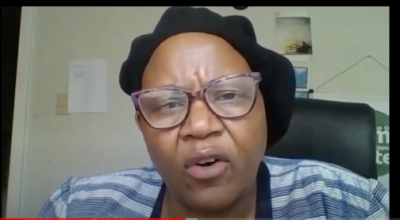
- Women’s wings in parties could play a key role. But it is also a very challenging position to be in, says Mona Krook.
- Women in parties talk among themselves, but they find it difficult to bring it up. They fear it will make their party look bad. It’s difficult because of party loyalty and pressure from people you care about. Several political parties develop a code of conduct.
Dil Maya Rai confirms the difficulties faced by female politicians, especially in situations where there are too few to form a women's wing. She stresses the need to counter the problem politically, fearing that denial by women parliamentarians may encourage violence against women.
What we took with us
Women at the event highlighted different points, which they found particularly useful:
- I found these points very interesting: the fact that violence against women in politics is so under reported and discussed that even the #Metoo Movement didn’t highlight it; and the fact that women are unable to influence neither the ideology nor the workings of political parties….so true!
- I want to highlight the need to advocate and help women politicians to overcome their state of denial or shame …so they feel safe and proud to reveal and share their experiences.
- We must be better at addressing the cultural aspects when it comes to violence against women in politics.
- Try to speak up, whenever possible - and raise awareness. That’s my main take away!
Nordic launch of “Violence Against Women in Politics” by Mona Lena Krook, Professor of Political Science & Chair of the Women and Politics program, Rutgers University.
International panel on experiences:
- Dil Maya Rai, member of Parliament for DNT, the ruling party of Bhutan
- Juliet Kaira Chibuta, Executive Director of Zambia National Women's Lobby.
- Thoko Matshe, Country Coordinator for Palme Center, South Africa
Arranged by DIPD in collaboration with Demo Finland and Oluf Palme Center.
